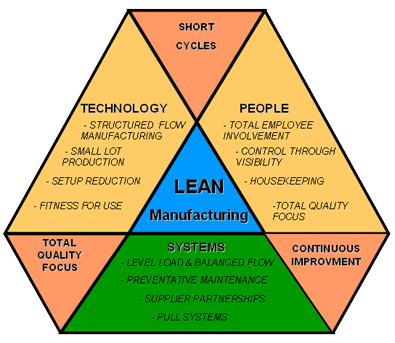 Lean manufacturing and lean dynamics processes separate the best business from all the rest, especially during times of crisis. Companies embracing “lean” concepts understand the reality of today’s business model: emergency conditions are no longer the rare exception to business as usual. The business must incorporate the constant and present danger of extreme conditions into its normal operations and procedures. Lean manufacturing and outlook sustains profitability while supporting revenue growth and innovation throughout the enterprise. Lean processes transform the organization.
Lean manufacturing and lean dynamics processes separate the best business from all the rest, especially during times of crisis. Companies embracing “lean” concepts understand the reality of today’s business model: emergency conditions are no longer the rare exception to business as usual. The business must incorporate the constant and present danger of extreme conditions into its normal operations and procedures. Lean manufacturing and outlook sustains profitability while supporting revenue growth and innovation throughout the enterprise. Lean processes transform the organization.
20th Century innovation. Henry Ford’s manufacturing process is a grandfather of lean manufacturing. Ford’s concept whittled away waste while streamlining labor needed to assemble a complex product. Ford’s concept also drove down costs. A relatively affordable must-have automobile created enormous demand. The Model-T was a vehicle for the mass market.
Management’s goal in the manufacturing process is to maintain while continually refining and tightening wasteful process. In Ford’s early example, management couldn’t demand stable operations. Market demand expanded manufacturing production, and factory managers seemed to constantly implement new strategies to keep a reliable number of Model-Ts rolling off the lines. Ford’s successful manufacturing continued to drive through process shortfalls for years. The company realized within the first 20 years of operations that business was never going to be ‘stable,’ and that embrace of evolution and change was necessary to survival.
Lean companies continue to focus on operations efficiency and innovation. The most successful organizations know there is never a pinnacle of manufacturing efficiency. Operations stability and sales growth and business expansion must align within the lean manufacturing organization.
Lean manufacturing solutions.
According to author Stephen Ruffa, (“Going Lean”) a decade of research into the nation’s 12 largest aerospace firms yielded surprising results. At the outset of Ruffa’s research, companies’ “manufacturing inefficiencies were high, flexibility low, and quality came at an enormous price.” These companies did not overcome wasteful process by exploring solutions to known problems. Instead, the companies implemented changes below the surface. Once addressed, many of the individual issues at the operations and process levels disappeared. Implementation of new internal initiatives automatically dealt with external items, e.g. access to critical spare parts and supply chains. At conclusion of a 10-year period, the aerospace industry (from Boeing to General Electric) changed from within: they learned to manage external conditions by making internal, organic changes.
Unpredictable business conditions and lean standards.
Some leaders suspect that rigidity may be the backbone of lean process, but the opposite is true. Innovation and exceptional flexibility is valued in the lean manufacturing organization, allowing the business to adapt and respond to twists and turns of the external environment as they occur. Streamlining of the lean manufacturing process enables the business to design and roll out new services or products. The lean organization focuses on low cost structure at its basis, providing available capital needed for updating or tweaks. Rather than respond to the problem with a solution, lean manufacturing focuses on the business’s underlying structure first. Manufacturing costs are continually driven down in the lean business. New development, less expensive to implement in the lean organization, creates customer value–the organization must respond to customer demand and integrate customers’ needs into the manufacturing process. Satisfied customers continue to buy products and services from the company.
Manufacturers, distributors, outsourcing and workarounds.
The ideal lean manufacturing organization does not rely upon stockpiling hard-to-get components or materials needed in the manufacturing process. Workarounds, in response to shortage or impacts of stockpiling, often don’t work. Today’s lean organization seeks to outsource many functions previously achieved the internal workforce. Companies don’t purchase, sell or store massive amounts of components needed in the manufacturing process. The company’s suppliers contract to deliver necessary amounts of any number of items, precisely as they are required. Rather than manage enormous inventories, the company manages the measurement of suppliers’ performance according to contract agreements. The decision to remove warehousing or storage of materials from the company’s operations can make a huge impact. Savings to the organization are immediate, and the company’s bottom line improves.







